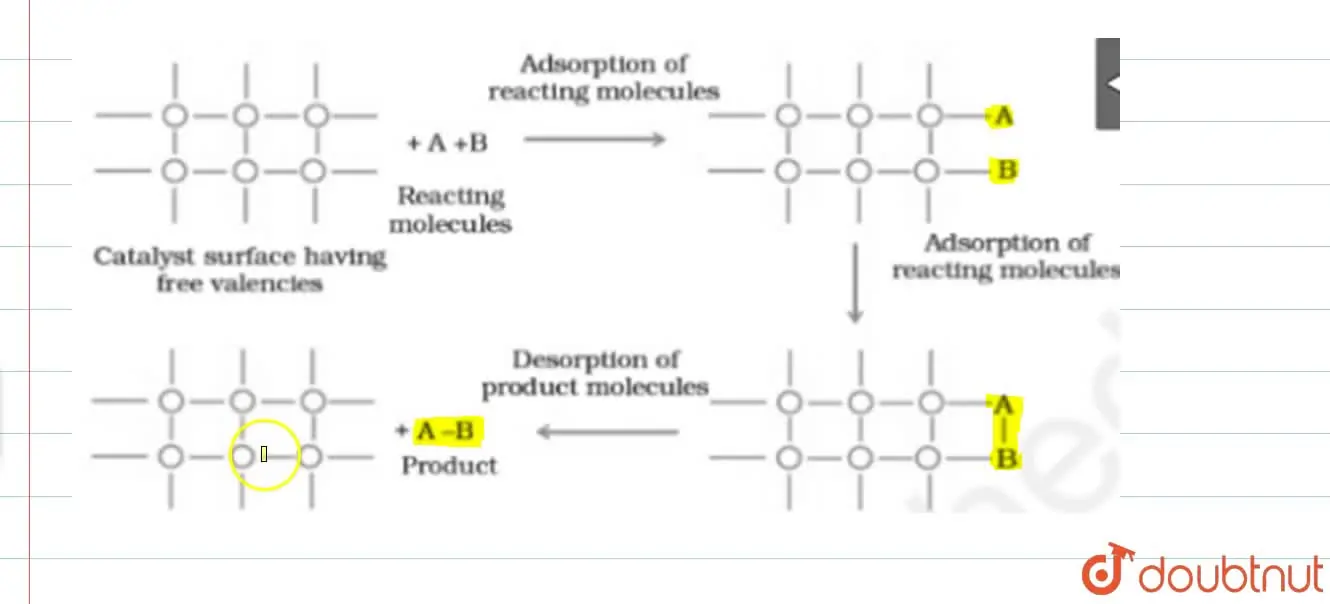Adsorption Theory Of Heterogeneous Catalysis
Adsorption Theory of Heterogeneous Catalysis
What is Catalysis?
Catalysis is the process where the rate of any reaction is changed (increased or decreased) by the existence of a substance, which itself remains unaltered chemically in the reaction. The substance which alters the rate of the reaction is called catalyst.
Types of Catalysis
Catalytic reactions are of two types:
a) Homogeneous Catalysis
b) Heterogeneous Catalysis
Homogeneous Catalysis
A catalytic process where catalysts and the reactants are in the same physical state, then it is called homogenous catalysis.
Heterogeneous Catalysis
A catalytic process where the catalyst and the reactants are in different physical state of matter , then it is called heterogeneous catalysis. It is also known as surface catalysis or contact catalysis.
Related Video:
Mechanism of Heterogeneous catalysis
As per Surface adsoprtion hypothesis heterogeneous catalysis involves five steps:
Step 1: Diffusion of Reactant(s) to the Surface: The rate at which reactants will diffuse to the surface will be impacted by their mass concentration and by the thickness of the surface layer.
Step 2: Adsorption of reactants: Bonds are shaped as the reactant(s) are adsorbed onto the surface of the catalyst. The capacity for an atom or molecule to stick to the surface is referred to, splendidly, as the Sticking Co-proficient. This is just the proportion or level of molecules that wind up sticking on the surface.
Step 3: Reaction: Bonds structure between the atoms and molecules on the surface.
Step 4: Desorption of products: Bonds are broken as the product(s) desorb from the surface.
Adsorption Theory of Catalysis
Adsorption hypothesis of catalysis explains the mechanism of heterogeneous catalysis for the most part. The old perspective was that when the catalyst is in solid phase and the reactants are in gaseous phase or in solutions, the molecules of the reactants get adsorbed on the catalyst surface. Adsorption is an exothermic process, the heat of adsorption is held by the catalyst surface, which is used on enhancing the chemical movement of reactant molecules.
The modern adsorption theory is the mix of moderate compound development hypothesis and the old adsorption hypothesis.
- The Catalytic movement is situated on the catalyst surface. The mechanism involves five steps. Diffusion of reactant on the catalyst surface.
- Adsorption of reactant molecules on the catalyst surface .
- Occurrence of chemical reaction on the catalyst surface through development of intermediates.
- Desorption of chemical reaction products from the catalyst surface .
- Diffusion of reactant products from the catalyst surface.
Adsorption Theory of Catalysis
According to the old adsorption hypothesis of catalysis, the reactants in their gaseous phase or in their dissolved phase in any solution are adsorbed on the surface of a catalyst in its solid phase. Consequently, the increase in the grouping of the reactants on the surface of the catalyst, accessibility, and likelihood of the event of a reaction between two species increases, and thus the rate of the reaction increases. Also, as the reactants hold readily to the surface of the catalyst some measure of energy is released as the process is exothermic. This heat of the combination is used in the reaction between the two species, thus accelerating the rate of the reaction.
According to the middle of the road compound hypothesis of catalysis, the reaction that is desired is accomplished with the arrangement of a moderate compound and the accompanying decomposition of the same into the desired products. Right now, catalyst is recovered after the reaction is finished.
Heterogeneous Catalysis Steps
Presently, according to the modern adsorption theory, which is a blend of the old hypothesis of adsorption and the halfway hypothesis of compound development, the process of heterogeneous catalysis involves five stages.
• The reactant molecules diffuse to the catalyst surface. The reactants stick to the outside surface, out of which some of them cross the boundary and enter the inside exposed surface that includes paths and cracks on the outer surface.
• The reactant molecules at that point get attached to the suitable sites accessible for adsorption process.
• The reactant molecules bound to the catalyst surface have a higher likelihood of responding with one another, and after the reaction, they form an intermediate compound.
• After this process, the middle of the road compound gets desorbed from the surface, which again becomes accessible for adsorption for different molecules to come.
• The intermediate compound at that point disintegrates to yield the final products, which at that point diffuse out of the inside pores and the external catalyst surface.
During the entire chemical reaction, the catalyst remains unaltered and is regains its structure once the reaction is finished. The mass and the chemical composition of the catalyst are not modified all through the process. We can't clarify the idea of reactant promoters and inhibitors through the moden theory of adsorption.
Important Chapters:
Similar Questions
Write the steps of 'Modern Adsorption Theory of Heterogenous Catalysis'
View SolutionModern theory of heterogeneous catalysis is
View SolutionWhat role does adsorption play in heterogeneous catalysis?
View SolutionWhat role does adsorption play in heterogeneous catalysis ?
View SolutionWhat role does adsorption play in heterogeneous catalysis ?
View SolutionWhat role does adsorption play in heterogeneous catalysis ?
View SolutionEnzyme Catalysis
View SolutionWhat is the role of adsorption in heterogeneous catalysis?
View SolutionDefine adsorption with an example. What is the role of adsorption in heterogeneous catalysis?
View SolutionWhich one of the following statements is incorrect in the case of Heterogenous catalysis
View Solution


